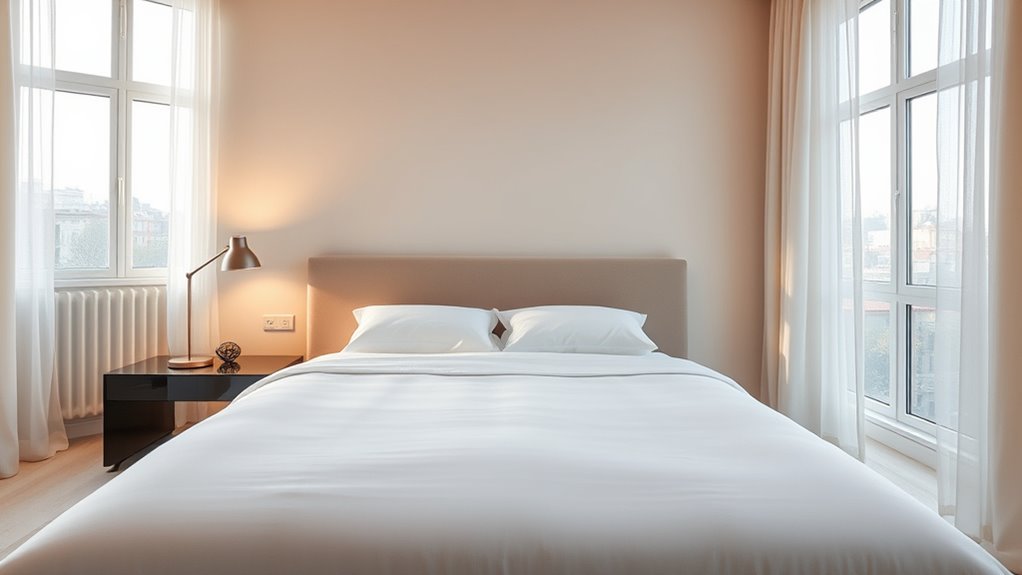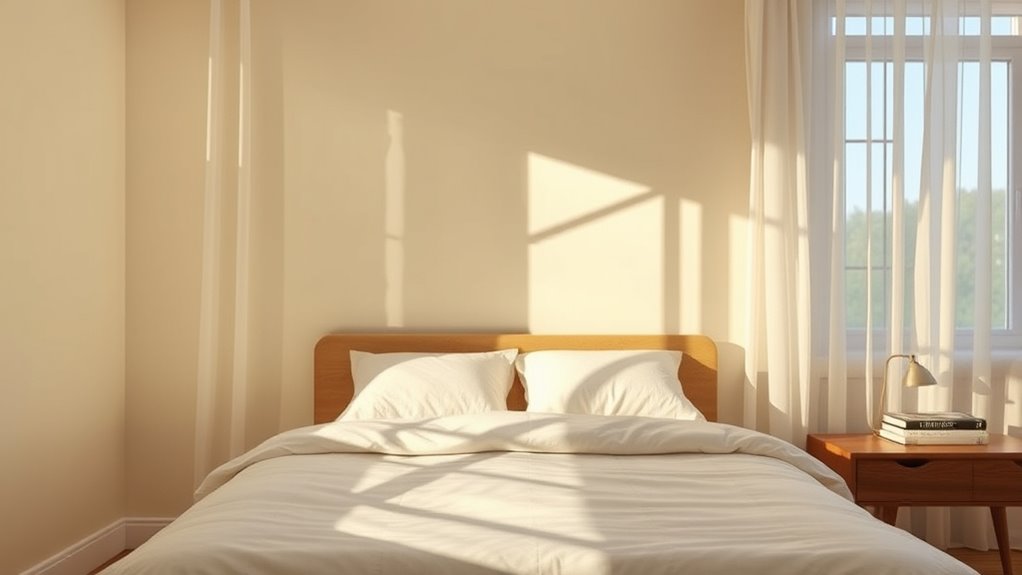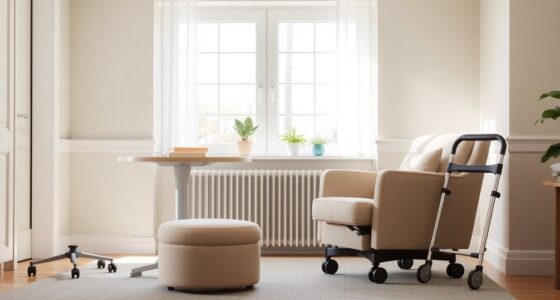When placing your bed, keep it a few feet away from lifts or elevator doors to reduce noise and vibrations that can disrupt sleep. Position the headboard away from shared walls with the lift shaft and choose corners or farther walls for a quieter experience. Align your bed to face natural morning light from east or southeast windows to wake gently. Staying mindful of these tips can help create a peaceful sleep space—continue to learn more for ideal comfort.
Key Takeaways
- Keep the bed several feet away from the lift to reduce noise and vibrations that can disturb sleep.
- Position bedside tables within easy reach without obstructing pathways or creating clutter.
- Arrange the bed to face east or southeast windows to maximize natural morning light entry.
- Avoid placing the bed directly against walls shared with the lift shaft to minimize noise transmission.
- Create an open, balanced layout that allows smooth movement and minimizes cramped or tight spaces.

Where you place your bed can considerably impact your sleep quality and overall room harmony. The position of your bed influences how restful your nights are, how the room feels, and even how energized you wake up in the morning. When considering where to put your bed, think about nearby features like lifts, bedside tables, and natural light sources. Each element plays an essential role in creating an environment that feels comfortable, functional, and inviting.
If your room has a lift or elevator nearby, it’s best to position your bed so that you’re not directly aligned with it. The noise and vibrations from the lift can disturb your sleep, especially if it operates frequently or loudly. Placing your bed a few feet away from the lift’s door can help reduce noise transmission and create a more peaceful sleeping space. Additionally, avoid placing your headboard directly against walls shared with the lift shaft, as vibrations and sounds tend to travel through walls. Instead, position your bed in a corner or along a wall that’s farther from the lift to minimize disruptions.
Your bedside tables should be conveniently located for easy access but not so close that they clutter the space or block pathways. When placing your bed, consider leaving enough room for a bedside table on each side if possible. This setup allows you to keep essentials like a lamp, water, or your phone within reach, without cramping the space or creating a crowded feel. Keep in mind that cluttered surfaces or tight corners can hinder movement and make the room feel cramped and less restful. The goal is to create a balanced layout that promotes both function and tranquility.
Place bedside tables for easy access without cluttering or blocking pathways.
Morning light is a powerful element in bed placement because it can influence your wake-up routine and overall mood. Position your bed so that natural light filters into your room in the morning, ideally from a window that faces east or southeast. This way, sunlight can gently wake you up, boosting your circadian rhythm and helping you start the day energized. Avoid placing your bed directly under or against a window, which may expose you to drafts, noise, or direct sunlight at inconvenient times. Instead, position yourself so that the light enters the room softly and gradually, creating a welcoming atmosphere in the early hours. Remember that attention to these details can significantly enhance your overall sleep experience and well-being.
Frequently Asked Questions
How Does Bed Placement Affect Sleep Quality?
Your bed placement directly impacts your sleep quality by influencing comfort, light, and noise levels. If you position your bed away from windows or noisy areas, you reduce disturbances. Facing natural light in the morning can help regulate your sleep-wake cycle, making it easier to wake up refreshed. Ensuring your bed is in a quiet, dark spot promotes deeper, uninterrupted sleep, leaving you feeling more rested and energized.
What Are the Best Positions for Bedside Tables?
Think of your bedside table as a trusted friend—close enough for easy reach, but not in your way. You should place it within arm’s reach on either side of your bed for convenience. Keep it clear of clutter to avoid distractions. A good rule is to position it about 2 feet from the bed’s edge, ensuring you can reach your essentials effortlessly, helping you relax and sleep better.
How Can I Optimize Morning Light Exposure?
To optimize your morning light exposure, position your bed near a window that faces east. Keep your curtains light and sheer to allow natural sunlight to flood in, waking you gently. If possible, avoid heavy drapes or obstructions that block sunlight. You can also place a mirror opposite the window to reflect more light into your space, helping you start your day energized and refreshed.
Does Bed Orientation Influence Energy Flow?
Think of your bed as a vessel for energy. Its orientation can direct positive vibes into your life or allow negative ones to linger. When you align your bed toward the sunrise, you invite fresh energy and clarity each morning. Conversely, facing away might block that flow. You hold the power to shape your energy flow simply by choosing a position that welcomes liveliness and serenity.
Are There Cultural Preferences for Bed Placement?
Yes, cultural preferences greatly influence bed placement. In some cultures, you might prefer placing your bed facing a specific direction, like east, to align with spiritual beliefs or traditions. Others may prioritize privacy or family customs, positioning beds away from doorways or windows. You’re likely to adhere to these practices to honor your heritage, promote harmony, or ensure good energy flow, making the space more comfortable and culturally meaningful for you.
Conclusion
Imagine your bedroom as a ship, with your bed as the captain’s station. Proper placement guarantees you sail smoothly through restful nights and energized mornings. When you position your bed thoughtfully—away from drafts and with morning light in mind—you create a sanctuary that nurtures your well-being. Just like a well-placed compass guides a sailor home, your bed’s placement can steer you toward better sleep and brighter days. Make your space work for you, and wake up ready to conquer.








